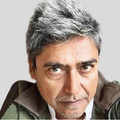 Reuters
ReutersI remember getting fascinated by the colour photographs in The Illustrated Weekly of India of the players who were about to play in the 1969-70 India-Australia series. The players were all caught in posed action with the green contrasting beautifully with the white of their pads and gloves, the cream yellow of their bats, the bright red of the ball. Those photos were the last I saw of the players before they turned into headlines and columns in the dailies and before they turned into sound, their actions conveyed through the crackle of the commentary on All India Radio across the five-Test series.
People a few years older than me remember staying up for commentary from that legendary 1970-71 tour of the West Indies, which gave us Sunil Gavaskar, among other gifts. I only remember the newspaper reports and the very short clips on the Films Division newsreels that came on before the main feature in cinemas, which were mainly ruled by the stately voice-overs. In the meantime, actually playing the game had its own soundscape: tennis ball or 'duce' ball on dirt or concrete; the hollow plastic 'ball' in which Farinni sold its ice-creams, which had a cap that, in the hands of skilful adepts, could clip off as the delivery pitched, making the rest of the ball cut viciously into your stumps.
Then, gradually, came the sound of proper cricket equipment, balls and bats, stumps with bails that flew off with a rattle that was sickening or satisfying, depending on whether you were batting or fielding. For a wannabe wicket-keeper like me, there was the soft thud of the ball as it nestled in the padding of my gloves. The one thing that remained constant from gully to club cricket was the constant shouting of boys as they verbally tore at their hair in despair or triumph.
A proper stadium like Eden Gardens had its own acoustics. The sound changed over the day as you watched a Ranji Trophy game unfold. There was the chatter of players knocking up in the winter morning before the crowd was fully in, echoing off the empty stands the taps as balls were gently middled in practice, the hiss as a properly fast throw was swallowed by a proper keeper's gloves, the absence of pounding as proper cricket shoes slid across the proper grass of the outfield.
When the match began there was an odd reverberating silence, as if you were in a vast open air church. The familiar sounds now came from a distance, filtered by the sense of ritual. Occasionally, you could hear the fast bowler's delivery stride; the ball carry into the keeper's gloves; an appeal that saw the strokeless opening batsman turning and walking back to the pavilion - what was that? LB? Caught behind? Then the arc of the bat, the ball disappearing somewhere on the green, followed a beat later by the report of the stroke. As the day wore on and the crowd thickened, you would get shouts from the stands.
In a Test match or ODI, this turned into a constant Niagara of massed sound, dropping and rising with the action, but never quite absent, always at least the murmur of a few thousand throats, even between deliveries. Watching the Ashes and the South Africa-India series with their cavernously empty stadiums you realise that big match noise is one of the central things that formed modern colour TV cricket coverage. It's great how in this Cov-silence you can now hear intimate chatter from the stump mikes, or indeed an umpire scoff at the DRS overturning his decision.
But that doesn't make up for the roar that the red or white sphere used to generate as it seared across the green towards the boundary rope. Regardless of the quality of the cricket, this silence reduces every match to a clash between two First Division clubs in an empty, off-season Eden Gardens.










 Get Unlimited Access to The Economic Times
Get Unlimited Access to The Economic Times
